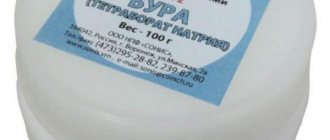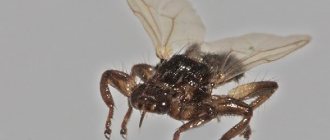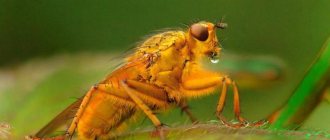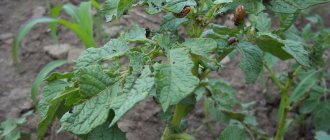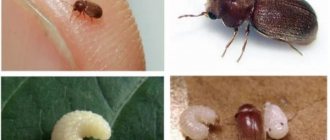Why is it dangerous for whiteflies to appear in a greenhouse?
The whitefly is a small insect of the order Aleurodidae.
Externally, it looks like a moth or midge 2-3 mm in size. The body is greenish-white, covered with a whitish coating. It has two pairs of white opaque wings and a small proboscis. With its help, the pest feeds on the sap of young plants. It can often be seen in beds with cabbage or cucumbers. The whitefly multiplies extremely actively in greenhouses where tomatoes are grown. It is especially dangerous in the summer. On hot days, no more than 3 weeks pass from laying eggs to the appearance of sexually mature individuals. And if the insect lays eggs mainly in the soil, then the larvae with rounded translucent bodies of a greenish or yellowish tint form colonies on the inside of plant leaves. They also feed on plant sap.
For vegetable crops, the rapid proliferation of whiteflies threatens death. The leaf blades turn yellow and curl, the plant slows down in growth, and the formation of new inflorescences and ovaries is reduced.
Attention! During their life, whitefly larvae secrete a sticky, sugary substance. It becomes a place for the development of sooty fungus. First, a white coating appears on the leaves, turning into black or brown spots. As the disease progresses, the fruits are also affected. Thus, gray-black small spots appear on tomatoes. Vegetables do not have time to ripen and lose their commercial qualities.
The peculiarity of the whitefly is that it settles in the greenhouse at the beginning of the season. The first to suffer is the planted seedlings. Therefore, experienced vegetable growers recommend inspecting the plantings 10-15 days after planting the plants in the greenhouse. It is difficult not to notice the insect. White moths flying up from the leaves and their larvae on the back of the leaf blades should be on your guard.
Whitefly damage
This insect makes punctures in the leaves of plants and sucks out the juice from there. This weakens the plant. During its life, the whitefly releases sweet substances on which fungi that are dangerous to garden crops can develop. The insect is especially dangerous for tomatoes, beans, cucumbers and eggplants. This pest contributes to the development of dangerous diseases for plants. There are cases when yields fell to a minimum. The pest is capable of destroying everything that is planted in open and closed ground. One plant may have pests in different life stages. This makes the fight more difficult. The damage caused by the whitefly is difficult to calculate, since it can destroy entire plantations of cultivated plants.
Nature of lesions
You can determine the presence of uninvited guests by the many white dots on the underside of the leaves, as well as by a shiny coating with dark spots. Very soon, due to the nutritional activity of the larvae, the leaves begin to deform and dry out, and new ones become smaller, the buds die, and fruits do not set. If measures are not taken to combat whiteflies in the greenhouse, the plants will begin to lack nutrients and die. But danger awaits them on the other side. The sooty fungus, which settles on the secretions of the larvae, covers the surface of the leaf and interferes with normal photosynthesis and respiration. The situation is aggravated by the emergence of infectious diseases, the causative agents of which are carried by adult males and females of whiteflies.
So, the signs of the appearance and reproduction of pests are as follows:
- Shiny or white dotted coating on leaves;
- Deformation of leaves and young shoots;
- Leaf curl;
- Chlorosis or yellow mosaic on them;
- At a late stage - necrosis of the fruits.
These symptoms should be a signal that urgent control of whiteflies in the greenhouse is necessary.
How to disinfect the ground
These larvae survive the winter in greenhouse soil. Therefore, it must be processed. The ideal solution is to remove the top layer, about 10 centimeters, and replace it with a new, disinfected one.
If this does not work, then dig up the ground and water it abundantly with one of the following preparations:
- "Confidor";
- "Verticillin";
- "Aktara";
- "Akarin";
- "Spark";
- "Mospilan";
- "Fufanon";
- "Aktellik".
They are prepared according to the instructions. The maximum effect is achieved if used at temperatures above +10°C.
If these drugs are not available, a harmless method is used. The ground is watered with boiling water in a proportion of 5 liters per 1 m2, covered with film for 72 hours.
Why do whiteflies appear in a greenhouse?
The whitefly pest in cold climates often attacks vegetation in greenhouses, however, the butterfly can also be found in the garden. At sub-zero temperatures, the insect dies, so it feels more comfortable indoors. In warm areas, it can overwinter in the ground, right on the garden bed.
Let’s take a closer look at why the whitefly “loves” greenhouse conditions so much. Let's find out what always attracts it indoors, and why it is necessary to fight whiteflies in a polycarbonate greenhouse. Insects are attracted to a closed space by conditions suitable for their life cycle and various ways of entering the greenhouse.
Suitable conditions for insects
Whiteflies can appear in a greenhouse greenhouse due to the following factors:
- improperly arranged ventilation process and temperature conditions;
- abundance of succulent plants;
- proximity to bush planting;
- the control of whiteflies in the greenhouse was carried out incorrectly;
- lack of fertilizing that helps strengthen the immunity of the crop;
- The seedlings were not sprayed.
Routes of entry into the greenhouse and signs of the appearance of a butterfly
The white butterfly, and this is what the whitefly pest looks like in a greenhouse, penetrates the greenhouses after purchasing and using the following purchased material:
- soil;
- indoor plants;
- vegetable seedlings.
Also, the whitefly insect is able to enter the greenhouse through the gardener’s clothing if larvae have been deposited on it.
Using smoke bombs
Fumigation with sulfur dioxide is a radical and effective method in pest control. Poisonous gas gets into all hard-to-reach places, deep into the ground. This way the insects are destroyed. Smoke bombs made from tobacco also have a detrimental effect.
To carry out cleansing in this way, you need to seal all the cracks. Place the checkers on stands made of non-flammable material and set them on fire. Quickly leave the premises and close the doors tightly.
Enter the greenhouse no earlier than after 3 days.
To increase the effect, it is recommended to pre-humidify the room.
How to get rid of whiteflies: control and prevention measures
You need to start fighting whiteflies immediately as soon as you see a couple of small white butterflies. It multiplies exponentially and very quickly becomes a real threat.
If you give up, the whitefly can be so annoying that the plants will drop flowers, buds and ovaries. It’s so easy to be left without a harvest.
Principles for effective whitefly control
Even if spraying does not rid the greenhouse and plants of all whitefly individuals, its number will be significantly reduced, which means the plants will have the strength to produce a full harvest.
1. Carefully and regularly inspect the plants, especially the undersides of the leaves
Difficulties in the fight against whiteflies are caused by the fact that the larvae settle and damage on the underside of the leaf. It can be difficult to reach each leaf and spray it from below, especially with a large growing area. With a hand sprayer it will not be possible to treat the plants efficiently. An automatic sprayer will help here, which evenly sprays the insecticidal solution in any direction.
How to detect the presence of whiteflies
The insect has an original appearance, so it is simply impossible to confuse it with others:
- The body is light green, and the wings are milky white.
- Superficially it resembles a moth, but has a more elongated body, 1-3 mm long.
- Whitefly larvae may have a yellowish or gray tint, and their mobility depends on the period of the life cycle.
Interesting! The pest feeds on plant sap and moisture concentrated on its leaves. Thus, the latter does not receive enough nutrients, slows down in growth and begins to fade.
Most often, the whitefly is concentrated on the lower part of the leaves, so identifying a newly founded colony is not so easy. Only after 2-3 days of infection the pest begins to emerge in abundance on the upper side. Affected foliage takes on the following appearance:
- Distinct yellowish spots begin to appear.
- First, clumps of dense cobwebs appear on the lower and then on the upper parts of the leaves. It cannot be confused with the rare, transparent spider web.
- The plant becomes covered with a kind of sticky film, on which dust and the remains of dry leaves collect.
How to recognize a whitefly infestation
Whitefly infestation is not easy to detect at the initial stage. This is explained by the fact that the insect nests mainly on the underside of the leaves, and its larvae are so small that they resemble small scales.
One of the characteristic signs that a plant is affected by whitefly is the appearance of whitish or yellow spots with blurred boundaries. The plants take on an unhealthy, depressed appearance; on the underside of the leaves you can see light tubercles - places where second-instar larvae accumulate.
When examining the leaves, their deformation and curling are noted. After a short time, the affected leaves turn yellow and die.
The secretions of the larvae cover the plant with a sticky coating, which is easily detected when touched. This plaque clogs the pores of the leaves, preventing natural photosynthesis and normal plant development. If black velvety spots are found on the leaves, then we are talking about a concomitant disease - sooty fungus, which is carried by whiteflies.
If any of the listed signs of an unhealthy plant appear, urgent measures should be taken to save the crop.
Whitefly growth stages
It takes 25-40 days for an adult pest to develop from the egg stage. The time period depends on humidity and temperature. The higher they are, the less time it takes to transform an egg into an adult insect. From the moment the eggs are laid, the whitefly goes through developmental stages. In each of them, the white fly causes different harm to the culture on which it lives.
- Tramp larvae. They hatch from the eggs after 11-12 days. Their size is about 0.3 mm, and they are already able to spread across the leaves in search of a better place to live and feed.
- Nymph larvae. They are securely fixed to the inside of the leaves and pierce them to obtain nutritious juices. This occurs approximately 5 days after the completion of the first stage. At the same time, they are absolutely motionless. Such whitefly larvae are difficult to see, as they are green in color and look like thin scales. At this stage of butterfly development, a waxy armor is formed, which makes it resistant to insecticides.
- Doll. This stage completes the formation of the pest and takes 7-30 days. At this stage, all methods of getting rid of whiteflies are ineffective.
- Imago formation. Adult insects are ready to independently eat leaves and further reproduce.
How to prevent it from appearing
Actions related to the fight against whitefly should begin in the fall, immediately after harvest. To do this, you need to completely remove plant debris from the greenhouse. This way you will reduce the likelihood of the pest getting into the ground, where it can easily overwinter and wait until spring.
In the spring, at the seedling propagation stage, do not place seedlings next to home crops. The whitefly loves geraniums and pelargonium, from where it moves to young shoots, and with them ends up in the greenhouse. Therefore, try to ensure that indoor flowers and seedlings of tomatoes, cucumbers, and peppers are located on different windowsills.
What to do in a greenhouse in the fall if a whitefly appears in it
You shouldn’t wait until autumn to start fighting the pest. There is a high probability of being left without a harvest. In the fall, greenhouses are finally treated for whiteflies and more to prevent re-infestation next season.
Timing for treatment of greenhouses against whiteflies in autumn
Treatment of the greenhouse in the fall, if there is a whitefly in it, is carried out as soon as possible after the final harvest. The fact is that most drugs do not affect egg laying. This means that 2 or even 3 treatments will be needed, which must be completed before the onset of frost. This is the only way to destroy the entire population.
Preparing the greenhouse for processing
Before you start treating a polycarbonate greenhouse in the fall against whiteflies, it needs to be prepared for this process.
After harvest:
- remove all plant remains, fallen fruits, branches, leaves;
- remove auxiliary equipment, ropes for tying or supports;
- remove rhizomes;
- carefully weed out weeds;
- wash all surfaces of greenhouses both inside and outside with a solution of laundry soap at the rate of: 1 grated bar per 10 liters of water;
- metal structures are treated with a solution of copper sulfate or kerosene;
- wooden parts or supports are whitewashed.
After preparatory activities, the soil is dug up to a depth of 30-40 cm.
How to treat a greenhouse in the fall against whiteflies with biological products
You can also treat the greenhouse and plants with products of biological origin, such as Bitoxibacillin, Avertin-N or Aversectin C. They are relatively safe for humans and do not accumulate in plant tissues.
There are also hormonal drugs. “Admiral” or “Match” products affect the reproductive system of whiteflies, negatively affecting its ability to reproduce. They also stop the growth of larvae.
Any biological preparations begin to work when they enter the intestines of an insect. There is no particular point in treating an empty greenhouse with them. In addition, they lose their effectiveness when the air temperature drops to 10 degrees Celsius or less.
Why are whiteflies dangerous on tomatoes?
The life cycle of a whitefly consists of three main stages: eggs, larvae, and adults. At the larval stage, the insect sucks the juice from the leaves, releasing a sticky enzyme, which is a favorable environment for the proliferation of sooty fungus. As a result, pathogens germinate in the tissues of the plant, which is expressed first by a white coating and then by black spots.
Therefore, double load on the plant causes its death. During hot weather, the reproduction process accelerates and from the egg stage to the adult is no more than 18 days. If measures are not taken in time, then you can completely forget about the harvest.
Note! A female whitefly can lay about 300 eggs in one season.
Methods for controlling whiteflies in a greenhouse
I will present several effective ways to resist whiteflies, tested from my own experience. Their effectiveness depends on the stage of spread of the pest and the scale of its colonization of the greenhouse.
I recommend starting with mechanical, folk, biological, and agrotechnical methods. And only if they are useless, proceed to the use of pesticides. After harvesting, do not forget to treat the greenhouse so that overwintered pests do not encroach on future plantings.
Removing whiteflies mechanically
The easiest and safest way to control white-winged pests is manual collection. To make your work easier, I recommend using the instructions:
- Give your greenhouse plants a “bath day”: attach a spray nozzle to the hose and water the plants using the drip method. Direct the stream at the leaves and stems to wash the adults to the ground. I advise you to hold the shoots and foliage with your hands so as not to accidentally damage them.
- Dilute the soap solution: 100 g of fine shavings of tar or laundry soap per 0.5 liters of water.
- Arm yourself with rubber gloves and a sponge. Dipping a washcloth into the soapy solution, thoroughly rinse the stems and leaves on both sides. This way you will rid the plant of eggs, larvae, and harmful sticky plaque.
- As soon as it gets dirty, change the soap solution to a new one - this will make cleaning more effective.
The method is quite painstaking, but effective: if you have a small number of plantings in the greenhouse, in one procedure you can kill the voracious butterfly forever.
Biological method
Many resourceful gardeners do not spend their own energy fighting the pest - they prefer to leave this task to the natural enemies of the whitefly. Its most formidable opponent is Encarsia Formosa. This is the so-called “parasitic rider”. Encarsia females lay their eggs in whitefly larvae. From this, the latter quickly die.
Parasitic parasites are not common in the garden like chafers or ladybugs. You will have to purchase special test tubes, capsules with encarsia larvae. They are available both in garden centers and online stores.
The “consumption” of the natural enemy is very economical: one individual is required per 1 m2 of greenhouse. You should not be afraid of the spread of encarsia throughout the area: after the destruction of the whitefly in the greenhouse, the parasite will die, as it will lose its natural nutrition.
Agrotechnical means
You can fight whiteflies by planting plants in the greenhouse that the insect somehow does not like:
- tobacco;
- garlic;
- dandelion.
Don't forget about the natural enemies of voracious butterflies - ladybugs and lacewings. To attract insects, open the greenhouse windows and doors on a nice day. Ladybugs can be carefully collected in a box on your site and released in a greenhouse.
Chemical control agents
If you cannot cope with the whitefly using safe and readily available methods, it makes sense to turn to insecticides:
- "Spark";
- "Aktellik";
- "Aliot";
- "Biotlin";
- "Cypermethrin";
- "Neudosan";
- "Fufanon";
- "Alatar";
- "Confidor";
- "Malathion";
- "Aktara" and so on.
All the variety of chemical preparations are used according to a similar method: according to the instructions, a suspension of the required concentration is diluted, the liquid is poured into the barrel of the sprayer, and then the tops of the plants are irrigated with the solution. After processing, be sure to maintain the specified waiting period - it is unsafe to harvest the crop earlier and eat the fruits.
Remember that you will have to work indoors without access to fresh air. Therefore, you must have closed clothing and shoes, a hat, a respirator, safety glasses and rubber gloves.
Traditional methods and recipes
I will share with you effective non-standard methods that will help remove whiteflies from the greenhouse. I also recommend contacting them in cases where the butterfly invasion occurred during fruiting. It is not safe to use chemicals at this stage.
Fumigators
These are special devices designed to combat annoying mosquitoes and flies. A capsule is inserted into the device, a plate soaked in repellent emulsion is plugged into the network.
The only difficulty is running an electrical extension cable to the greenhouse. Close the windows, doors, and ventilators tightly, and then turn on the device. A few hours of work is enough for all the whiteflies inside to die. However, the beneficial insects inhabiting the greenhouse will also die along with them.
Herbal infusions
Let me present an effective “grandfather’s” recipe for a remedy made from yarrow:
- Collect the plant during the flowering period, dry it, and grind the dry mass.
- Fill a 10-liter bucket ¼ full with grass. Add the rest of the volume with water.
- Close the lid and leave in a warm place for 2-3 days.
- Strain the liquid and apply it to the plantings from the sprayer.
- For prevention, repeat treatment every 1-2 weeks.
The second effective infusion is garlic. It also has a bactericidal effect - it will help neutralize pathogenic fungi that multiply in the sticky waste of whiteflies:
- Pound and chop the garlic heads - you should get 1 cup of aromatic mass.
- Pour 10 liters of heated water over the garlic.
- Leave the mixture for 2 days, strain when ready.
- Use a spray bottle to spray each leaf of the affected plant on both sides.
- Repeat the treatment after 4-5 days until the pest is completely destroyed.
Another effective infusion is from dandelion:
- Grind 50 g of rhizomes and 50 g of green mass (without flowers) of the plant.
- Pour in 1 liter of water.
- Let it brew for 2 days.
- Strain and spray the plants with dandelion solution.
- After 2 weeks, repeat the treatment.
It is also effective to dust affected plants with tobacco dust and prepare liquid solutions based on it.
Traps
The use of glue traps is another sure and proven way to destroy whiteflies and other pests. They can be purchased at gardening stores or made by yourself. The main thing is that the base is bright yellow; it is this condition that attracts flies like a magnet. Any viscous substance that can not harden for a long time is used as a sticky base. This could be castor or car oil, epoxy resin without a hardener, or something else. In addition to whiteflies, such devices will attract aphids, fungus gnats, thrips, mining midges, fruit flies and other insects that are enemies of the gardener.
Healthy! If you use such traps throughout the season, problems with whiteflies and other pests most likely will not arise. The only thing you will need to do is update them periodically.
Celandine
To prepare the infusion, take 300-500 g of celandine leaves and pour 3 liters of water over them. The infusion is suitable for spraying after 2 days of infusion. Treatments can be duplicated every 7 days.
Chemicals
Another available method is to treat a polycarbonate greenhouse against whiteflies in the spring with chemicals. Various means are used for this:
- Copper sulfate (copper sulfate solution).
- Potassium permanganate.
- Various insecticides - Confidor, Akarin, Iskra, Aktara and many others.
Each of these remedies helps cope with both whiteflies and other pests. But they must be used with caution and strictly according to the instructions. For example, copper sulfate can be used no more often than once every 4-5 years. Otherwise, copper will not be removed from the soil in a timely manner, which will significantly reduce yields. The optimal dosage is 50 g of vitriol, 30 g of slaked lime per 10 liters of water. This volume is enough to treat 5 m2 of area (applied directly into the soil).
Potassium permanganate is also used to water the soil (to prevent the appearance of whiteflies in the greenhouse). Several crystals of powder are dissolved in 10 liters of water. As a result, the solution should become light pink, not saturated. Water 5-10 m2 of area. Potassium permanganate (like copper sulfate) can not only water the soil, but also disinfect the internal surfaces of the greenhouse. Before this, metal structures must be primed and painted.
Insecticides are used to treat the plants themselves during the growing season and flowering. It is better to use those drugs that give the longest lasting effect. For example, Confidor protects plants from whiteflies for 30 days. The solution destroys both the insects themselves and their eggs.
Confidor is an insecticide with an increased protective effect. Important! Experienced gardeners have long noticed that mosquito repellents and other insect repellents, which are plugged into a power outlet, also effectively destroy whiteflies. Therefore, next to the greenhouse, if it is possible to connect to the network, you can use an electric fumigator.
Fighting methods
The greenhouse whitefly is a frequent enemy of gardeners in central Russia. There are a lot of methods to combat insects, let's look at the most effective of them using specific examples.
Whitefly and its larvaeSource vseprodachu.ru
Manual method
The manual or mechanical method of controlling whiteflies refers to the collection of insects and clusters of eggs and larvae (if there are small numbers of them). If the concentration of moths is higher, they can be knocked down with a stream of water from a watering hose. After the plants are cleaned, each leaf (on both sides) is wiped with a solution of laundry soap (proportions 1 to 6). At higher concentrations, a household vacuum cleaner can be used. With its help, you can not only knock down harmful tenants, but also spray soap concentrate.
How to deal with whiteflySource vosaduly.ru
Use of drugs
How to poison whitefliesSource vosaduly.ru
The use of chemicals is one of the simplest and most effective ways to combat whiteflies in a greenhouse. It should be understood that such prevention has a negative impact on the environmental purity of the resulting fruits. The simplest and most popular means and methods of their use are given in the table below:
| A drug | Action | Application |
| Pegasus | Destroys adults, larvae and eggs | Use at least once a week. |
| Monsoon | Maintains the effect for 21 days. | Can be used once. |
| Inta-Vir | Affects adults, larvae, imago. | Sprayed with the composition, calculated as 2 tablets. for 10 l. During the summer, no more than three treatments are allowed. |
| Aktellik | Retains its properties for 12 days after treatment. | Apply no later than a month before harvesting the fruits. |
| Aktara | Protects the plant for a whole month; when applied to the soil, the period is extended by 2 times. | Sprayed at the rate of 2 liters. per 100 m2 area. Repeated watering – 10 m2 per 10 l. |
Don't forget about personal protective equipmentSource ic.pics.livejournal.com
Traditional methods
We destroy whiteflies by watering plantsSource fermoved.ru
Spraying with herbal solutionSource oteplicah.ru
Such methods, similar to manual ones, are not as effective as spraying with chemicals, but they guarantee the absolute environmental friendliness of the resulting crop. Used by experienced gardeners and mainly in small areas:
- Mentioned earlier, the so-called wet cleaning. The leaves are wiped with water with laundry soap added to it.
- Another way to combat whiteflies in a greenhouse is to periodically water them with the same soap solution. This measure is applied no more than once a week. Otherwise, there is a possibility of harming the plants.
- The whitefly is also afraid of garlic solution. The composition is prepared from two slices and 1 liter. boiling water Leave the resulting mixture to brew for 10-12 hours, then you can spray the plants.
- The yarrow solution is prepared according to the following proportions: mix 100 g of foliage with 1 liter. water. Leave for two days and treat the affected plants.
- The composition of dandelion leaves is prepared as follows: finely chop 40-50 g of leaves and the same amount of roots, soak in 1 liter. water and leave to infuse for 2-3 days.
- Ammonia concentrate in an amount of 30-40 g is diluted in a bucket of water. Spraying is performed every 3-4 days.
- The whitefly is also afraid of a solution of vinegar essence diluted in a bucket of water. For this you will need only 5 tbsp of acid. l.
Traps
The use of glue traps is another sure and proven way to destroy whiteflies and other pests. They can be purchased at gardening stores or made by yourself. The main thing is that the base is bright yellow; it is this condition that attracts flies like a magnet. Any viscous substance that can not harden for a long time is used as a sticky base. This could be castor or car oil, epoxy resin without a hardener, or something else. In addition to whiteflies, such devices will attract aphids, fungus gnats, thrips, mining midges, fruit flies and other insects that are enemies of the gardener.
Sticky traps in a greenhouseSource img-fotki.yandex.ru
DIY whitefly trapsSource livejournal.com
Herbal infusions and herbal decoctions
Not every method gives the desired result, however, when a person does not want to use chemicals, he should use proven herbal infusions:
- Dandelion root tincture. It will take approximately 100 g. Afterwards, the raw materials are poured with boiling water. Next, leave for 1 day and spray the tomatoes.
- Sugar solution. Dissolve 2 tbsp. sugar in 1 tbsp. with water and treat plants where there are manifestations of insect damage. When it doesn’t help, spraying is repeated after a week. After a week, the leaves are sprayed with water to remove sugar coating.
- Garlic tincture. Crush 15 g of garlic cloves and add 100 g of water. Cover with a lid and infuse for 5 days. The product turns out to be extremely saturated, therefore, to treat the plants, you need to mix 5 g of solution in 1 liter of water.
- Tincture of tobacco dust. Prepare as follows: 1 package per 1 liter of water. This mixture is infused for 7 days. You need to spray every 5 days.
- Lemon peel tincture. 100 g of the product is poured with water, left for a day, then 60 g of a solution with soap is added, and the damaged parts of the plant are treated.
- Ammonia. For 10 liters of water you will need 35 ml of 10% ammonia solution. Plants are sprayed with it. A similar method is used before tomatoes bloom.
- Yarrow tincture. The grass is finely chopped, scalded with boiling water, 1 liter of water is poured in and infused for a day. Treat the affected plants: when the foliage is large, wipe with cotton wool soaked in the tincture. For plants with small leaves, spraying is more effective.
When treating plants for whiteflies, it is extremely important to focus on the lower areas of the foliage.
Chemicals
It should be noted that almost all of the drugs listed below are very good and effective. The main thing is to strictly follow the instructions and observe safety measures when processing plants, since the toxic substances included in the composition are harmful to humans.
"Aktar". Treatment with this substance helps remove whiteflies for a period of up to 1 month. Treatment is repeated 3 times every 7 days to destroy midges in all life cycles of development. Vegetables can be eaten only after 60 days after the last application of the drug "Aktar". 1 sachet, containing 4 g, is diluted in 5 liters of water. This is enough for a large greenhouse area. To destroy, spray and water at the root.
"Aplaud." Can be used both in greenhouses and in open ground. Japanese insecticide allows you to get rid of insects for 1 month. Diluted 0.5 kg per 1 ha. To process 1 hectare you will need 1500 liters of water.
"Confidor". The drug is quite effective, so one treatment is enough. After an hour, the midges begin to die.
"Iskra Golden" These are tablets that easily dissolve in water. Also available in the form of ampoules, powder and sticks. A solution of 2 ml per 10 liters of water is prepared and sprayed on the plants. 1 or 2 treatments with Iskra Zolotoy are enough.
"Tanrek". A very effective and low-toxic substance that practically does not accumulate in fruits. To spray vegetables and indoor plants, you need to take 5 ml of the drug per 10 liters of water, for trees and bushes, 3 ml. Safety precautions must be observed when working with Tanrek, so be sure to wear respirators or face masks.
Biological countermeasures
Another no less effective, but completely environmentally friendly way to combat it is the use of other insect competitors. By planting just a few representatives of one species or another, you can completely disrupt the pest plantation without the risk of harming the plantings. Below are some of the most inveterate enemies.
Macrolophus caliginosus is a voracious predator bug that feeds on many insect pests. It is used as one of the highest quality and proven methods of combating aphids, whiteflies, spider mites, and tomato leafminer moths. It is advisable to populate them every 2 weeks for a month. After this, the insects will take root and begin to independently maintain their population.
The ladybug is one of the main enemies of many insect pests in garden plots. It feeds on whiteflies, aphids, scale insects, small caterpillars, spider mites, Colorado potato beetle larvae and many enemies of the gardener.
Encarzia is one of the most effective opponents of our pest. Belongs to the category of parasitic parasitic parasites, the larva of which pupates in the host's shell. About a week before planting the seedlings, place 3-4 bags of the parasite in the greenhouse. The females will independently find the whitefly and lay their embryos in its body, which will destroy their host.
Interesting! Common tansy planted in a greenhouse nearby provides good protection against whiteflies.
How to remove whiteflies from a greenhouse in winter using biological preparations
There are drugs that are not chemical because they do not harm plants, humans and animals. Biological preparations are based on living beneficial microflora.
For 100 m2 of greenhouse area the following are used:
- lepidocide - 30 ml per 10 liters of water;
- phytocide - 300 ml;
- bitoxybacillin - 100–150 ml.
You can soak the seeds in these preparations in the spring for additional disinfection.
The colonization of natural enemies of whiteflies is also used as a biological method. These include: ladybug, macrolophus bug, lacewing. But these insects do not live in winter, and therefore it is recommended to move them indoors in the spring, a few weeks before seedlings. With sufficient reproduction, the natural enemies of the whitefly can reduce the insect population several times.
Prevention measures
To avoid poisoning the pest in the fall, you should be careful with greenhouse plantings and avoid the occurrence of dangerous conditions that will be favorable for whiteflies and other pests. Prevention measures:
- when planting, all seedlings must be examined carefully on both sides of the leaf;
- Do not overfeed the plant with nitrogen fertilizers;
- strictly observe the watering regime;
- remove all weeds in a timely manner, and also avoid cluttering the area with grass.
Correct agricultural technology is the first preventative measure. If the plant has a strong immune system, it will itself repel pests. Treating a greenhouse against whiteflies in the fall is another preventive measure that will help fight the pest and prevent it from destroying the crop.
Preventing the appearance of whiteflies
After successful military operations, work on your mistakes and remember simple rules that will help you avoid pest invasion in the future:
- Use a substrate from a trusted manufacturer for planting seedlings, and be sure to disinfect your own prepared soil mixture before use;
- adhere to the correct planting scheme - the whitefly feels at ease in the seedling jungle;
- do not overdo it with watering - the pest has a special love for high humidity;
- regularly ventilate the room where the seedlings are located;
- maintain optimal air temperature when growing seedlings;
- Keep recently purchased indoor flowers away from seedlings - quarantine them in another room for 4-5 weeks.
We hope our tips will help you protect your seedlings from the machinations of whiteflies and allow you to make your dream of a decent harvest come true. And if you know other methods of combating this insidious pest, share your experience in the comments.
Conclusion
Getting rid of whiteflies in a greenhouse in the fall means protecting the next season's crop. Moreover, greenhouses in any case need to be prepared for winter. Otherwise, during the growing season you will have to resort to using various means of controlling pests and diseases, which negatively affects the quality of the crop.
Sources
- https://dachnoedelo.ru/tchem-obrabotaty-teplitsu-osenyyu-ot-belokrlki.html
- https://fermilon.ru/sad-i-ogorod/vrediteli/obrabotka-teplitsy-osenyu-ot-belokrylki.html
- https://parnik-teplitsa.ru/belokrylka-v-teplice-213
- https://zen.yandex.ru/media/lifehackneys/chtoby-izbavitsia-ot-belokrylki-ia-vsegda-obrabatyvaiu-teplicu-oseniu-rasskazyvaiu-kak-eto-nado-delat-5f3827448d67a852363de2e5
- https://m-strana.ru/articles/kak-borotsya-s-belokrylkoy-v-teplitse-5-deystvennykh-sposobov/
- https://dachnik0ff.ru/tepliczyi/belokryilka-v-teplicze-kak-izbavitsya.html
- https://belt-wrestling.su/muhi-i-moshki/kak-izbavitsya-ot-belokrylki-v-teplice.html
- https://wiki-dacha.ru/kak-borotsya-s-belokrylkoy-v-teplice
- https://AgroGnom.ru/building/hotbeds/obrabotka-teplitsy-ot-belokrylki-vesnoj.html
[collapse]
How to destroy whitefly for a summer resident
You can destroy whiteflies with the drug "Aktara".
Processing plants in a greenhouse. Photo from fermilon.ru
The active substance also works at the cellular level of the plant. If not all whiteflies die during spraying, then feeding will finish off the remaining ones after the end of hostilities.
You can choose the means to effectively combat this scourge - including Aktaru - on our market by comparing prices from different online stores. View a selection of insecticides for whiteflies.


